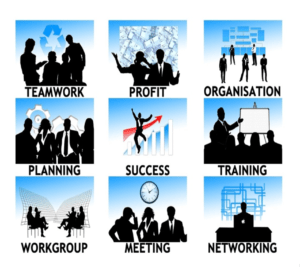Training is a process, not an event. It begins long before participants show up and continues until it shows in the workplace”….Bob Pike.

Last week, I looked at the effect that training leaves on the mind – a new mindsets, changes in atitudes and better appreciation of the corporate vision and mission of an organization. The fewer times an Disciplinary Committee meets on staff infringements, the better it is. Sometimes, the reason behind that infringement may only be due to lack of training, resulting in ignorance. At a period of continuous massive change in the financial services sector, coupled with closure of financial institutions, one should not be impervious to learning what went wrong and learning how to stay relevant to ensure survival in the marketplace as well as for ongoing survival for businesses. These days one should not stop learning when one graduates from school. Today’s successful leaders need to learn everything that is relevant to their businesses. The advent of sandwich programs, evening and week-end courses has helped many bank staff re-enter the formal learning system while others either rely on training offered by their institutions, or pursue self-development through reading, videos, podcasts, etc. In the new era of digital banking, there is a need to learn new skills in business today including coding, digital analytics and others. There is an obvious need for mastery of essential knowledge to apply data handling methods to inform business and financial decisions. While some organizations are embracing this need by committing to training their employees, most organizations expect employees to learn on their own.
Preparation Towards Training
During my tenure as a practicing banker, I was assigned at one time a temporary duty to conduct a branch-wide skills audit to make recommendations to the Divisional Head in the bank’s retail banking strategic drive. This involved visiting all branches, meeting them as a group, as well as conducting one-on-one chats with staff to identify their strengths and areas for improvement in their current roles. Certain staff members had either over-stayed on their work schedules, or were under-utilized, wrongly-placed, over-worked, or needed more training to fit into their job roles. Based on findings, some of these gaps were rectified. That was when I realized that some customer-facing staff were not appropriately fitted and belonged to back-office and other more analytical roles. Certain roles like front desk/customer service needs the person to have more soft skills in dealing with customers. Training is very key at all times, whether for technical or soft skills.
In modern times the appraisal system is also expected to be thoroughly executed for the mutual satisfaction of the system and the people. It should not be a time for punishment or revenge. Moreover, it is not a form-filling static activity, but should be a regular process to ensure the outcomes are relevant to the future of work. The new future of work also focuses on employees collaborating with automation and artificial intelligence to get work done efficiently and innovatively. These activities range from acquisition of skills involving analytic software and chatbots to robotics, with the power to learn and adapt using AI, natural language processing and machine learning. Such specialized skills require recruitment of the appropriately skilled workers while existing staff also learn to enhance their skills in this ‘man-machine relationship’. That is where the hard and soft skills come into play for optimum performance. Banks also need continuous design thinking to make customers’ pain-points along their digital journeys more seamless.
In-House Training Programs
Training will always be a part of every Bank’s program. The future of work demands that it involves a hybrid of physical and virtual training. Many banks have adopted e-learning systems where staff can refresh or update themselves in, at more convenient times, without travelling and incurring out of station costs. Apart from cost reduction, in-house courses are customized by internal resource specialists. Such training programs are usually specific, practical and relevant to the job descriptions of participants. Key lessons learnt from events are also shared for their guidance.
External Training Programs
External courses also enhance the exposure of participants to global standards and learning of lessons shared by peers or others in similar workplace environments. Best practices are shared while adequate networking also facilitates work among peers in the same industry. There have been several cases of training cohorts in bank external courses, assisting each other during suspected criminality of customers, loan recovery and risky transactions.
External consultants usually handle events or skills that cuts across the industry, gives overviews of modern local and global trends of both technical and soft skills, best practices, and strategic actions and their implications on the future of work. Training therefore should incorporate both internal and external methodology. Cohorts with less experience learn from the experience of some practitioners and vice versa. Such younger cohorts are more versatile in the new banking trends and such relationship become life-long valuable ones.
While finding skilled workers and retraining current employees is imperative, digitalization always result in some job losses because some employees would not be employable after the process or may not be able to adjust well in the new digital era. This phase needs to be handled with tact and transparency, with both the customers and the employees at heart. In our part of the world, with high illiteracy rates, what are the customers’ priorities? A millennial, banking in an upstage urban branch only needs digital bank to survive. They do not have time to meet bank functionaries unless there is a problem. However, an illiterate customer in a small remote branch in a rural community prefers to engage with people, since he or she may not understand the intricacies of some transactions. Re-tooling bank staff should never be cast in stone, because bankers need to know their customers’ personalities, needs and expectations in every setting. Identifying employees who are not too technologically inclined but more relational inclined do best in customer advisory, assisting with those who need simple services
Review of the Status of your Workforce – Useful Tips to Employers and HR Managers
Dear Manager, with the above discussions, I hope you will review your workforce status as you plan your next journey in projecting a positive and agile brand, with training as a firm foundation. Employers need to build an infrastructure that supports the future of work now, with HR leading the way in identifying and developing the types of workers they will need in the decade to come and beyond. Let me conclude my opinions with the following tips as food for thought.
- Understand the existing business of the institution and new expectations and the intricacies of the future of your work especially the effect of external and internal factors.
- Review current vision, mission, values and strategies of your institution
- Review strategic goals and objectives to meet the demands of the future of work
- Review job descriptions that are aligned with the new brand
- Conduct a skills audit of staff and identify gaps that need to be filled, such as an AI specialist, a coding ethics specialist, and other technical specialists to man the digital culture. Such persons may be found to have fewer soft skills and need to be trained.
- Involve leaders who can identify which technological methods can improve and support their activities, while upgrading existing staff to be more relevant.
- Select relevant staff to undergo re-tooling, refresher and re-assign duties where applicable.
- Strengthen the employee value proposition. Encourage a more employee-focused approach in new programs to get their buy-in and help retain talent in the most critical roles.
Dear Employers, CEOs and Managers, I am sure that maintaining the status quo is not in your dreams. Every leader aspiring to be transformational needs to include in the journey, a vibrant Human Resource and Learning and Development department that should emphasize not only an objective to attract and retain employees, but also include an emphasis on talent pipeline development, reskilling current workers to meet the ever-changing future of work demands and achieve a more dynamic organization.
TO BE CONTINUED
ABOUT THE AUTHOR
Alberta Quarcoopome is a Fellow of the Institute of Bankers, and CEO of ALKAN Business Consult Ltd. She is the Author of Three books: “The 21st Century Bank Teller: A Strategic Partner” and “My Front Desk Experience: A Young Banker’s Story” and “The Modern Branch Manager’s Companion”. She uses her experience and practical case studies, training young bankers in operational risk management, sales, customer service, banking operations and fraud.
CONTACT
Website www.alkanbiz.com
Email:alberta@alkanbiz.com or [email protected]
Tel: +233-0244333051/+233-0244611343










